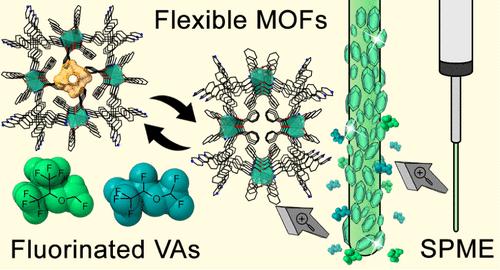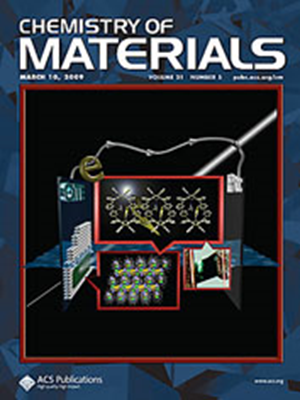A Flexible Interpenetrated Diamondoid Metal–Organic Framework with Aromatic-Enriched Channels as a Preconcentrator for the Detection of Fluorinated Anesthetics
IF 7.2
2区 材料科学
Q2 CHEMISTRY, PHYSICAL
引用次数: 0
Abstract
Flexible metal–organic frameworks (MOFs) are dynamic materials that combine long-range structural order with reversible stimulus-responsive phase transitions. In this study, we report the synthesis and characterization of two isoreticular flexible MOFs, TPPM-CPW(Me) and TPPM-CPW(Ph), constructed by combining the ligand tetra-4-(4-pyridyl)phenylmethane (TPPM) with specific Cu(II) paddle-wheel (CPW) secondary building units (SBUs). These MOFs exhibit reversible transitions between open- and closed-pore forms triggered by external stimuli, such as temperature- and pressure-induced guest removal and uptake. The stability of these frameworks is influenced by the residual equatorial groups on the Cu(II) SBUs, with phenyl-functionalized TPPM-CPW(Ph) displaying dynamic behavior characteristic of third-generation soft porous crystals. Notably, TPPM-CPW(Ph) exhibited high adsorption affinity toward fluorinated guests, including SF6 and volatile anesthetics (VAs) such as desflurane and sevoflurane. This material, when used in solid-phase microextraction (SPME) as fiber coating for the preconcentration of these VAs in air, outperformed commercial CAR/PDMS fibers, underscoring the potential of these versatile flexible MOFs in addressing environmental challenges associated with the use of volatile fluorinated compounds.

求助全文
约1分钟内获得全文
求助全文
来源期刊

Chemistry of Materials
工程技术-材料科学:综合
CiteScore
14.10
自引率
5.80%
发文量
929
审稿时长
1.5 months
期刊介绍:
The journal Chemistry of Materials focuses on publishing original research at the intersection of materials science and chemistry. The studies published in the journal involve chemistry as a prominent component and explore topics such as the design, synthesis, characterization, processing, understanding, and application of functional or potentially functional materials. The journal covers various areas of interest, including inorganic and organic solid-state chemistry, nanomaterials, biomaterials, thin films and polymers, and composite/hybrid materials. The journal particularly seeks papers that highlight the creation or development of innovative materials with novel optical, electrical, magnetic, catalytic, or mechanical properties. It is essential that manuscripts on these topics have a primary focus on the chemistry of materials and represent a significant advancement compared to prior research. Before external reviews are sought, submitted manuscripts undergo a review process by a minimum of two editors to ensure their appropriateness for the journal and the presence of sufficient evidence of a significant advance that will be of broad interest to the materials chemistry community.
 求助内容:
求助内容: 应助结果提醒方式:
应助结果提醒方式:


